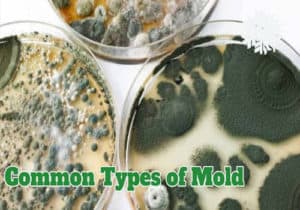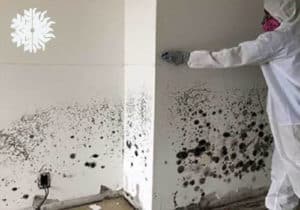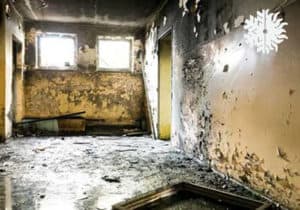Have you ever noticed a musty smell in your attic or did you see black spots on the walls and ceilings? If so, it’s possible that you have mold growing in your attic. Mold can cause serious health problems if left untreated, so it is important to learn how to remove mold from the attic before its effects become too severe.
We understand the frustration that comes with discovering mold in your attic and want to help you take care of it quickly and safely. In this article, we’ll provide detailed instructions on how to identify, remove, and prevent mold from growing in your attic.
Signs That You Have A Mold Problem In Your Attic Space
You can spot mold in your attic by looking for a musty smell or black spots on the walls and ceilings. If you do spot mold, it’s important to confirm that the black spots are actually mold and not dirt or some other substance. To do this, try to wipe off the substance with a damp cloth. If it smears instead of wiping away easily, then you will likely have mold growing in your attic.
Common Causes Of Mold In Attics
Common causes of mold in attics include high humidity, poor ventilation, and moisture buildup due to inadequate insulation, roof cracks, holes, or roof leaks. High humidity levels in the attic can cause condensation to form on the walls and ceilings, which can create ideal conditions for mold growth. Poor ventilation systems can also trap moisture in the attic, while inadequate insulation or roof leaks can cause moisture to build up in the attic and create a breeding ground for mold.
Safety Precautions For Removing Mold
It is important to be careful when having an attic mold removal project. Make sure you take safety precautions before starting the process.
- Wear Protective Gear: Make sure to wear personal protective gear, such as rubber gloves, eye protection, and a face mask when handling or removing mold.
- Open Windows: To reduce the risk of inhalation, open windows, and doors to allow air circulation in the area.
- Turn-Off Fans: Make sure to turn off any fans in the area before beginning the removal process.
- Keep Children and Pets Away: Keep children, pets, and other animals away from the affected area while you are working on removing the mold.
- Clean Up Thoroughly: Once you have removed the mold, make sure to clean up any remaining materials thoroughly.
Tools And Materials Needed To Remove Mold From Plywood And Wood Attic
When removing mold from your attic, it is important to have the right tools and materials on hand to ensure a safe and effective job. The following items are what you will need when removing mold from plywood or wood in your attic:
- Safety Gear – As previously mentioned, make sure to wear protective gear such as rubber gloves, goggles, and a respirator or face mask when handling mold.
- Plastic Sheet – It is also important to have plastic sheeting on hand to cover the floor of the attic while you are cleaning up the mold. This will help prevent further pollution from spreading.
- Disposal Bags – Make sure to keep disposable bags nearby to collect any moldy materials for disposal.
- Vacuum – A vacuum cleaner is also necessary to suck up the remaining debris and particles so that your attic is clean and free of mold.
- Cleaning Solutions – You will need to use a cleaning solution to properly remove the mold from the walls and ceilings in your attic. Many people choose to use a bleach and water solution, but there are also other products available that work just as well.
- Brushes and Sponges – Make sure to have a variety of brushes and sponges on hand to help scrub away the mold from your attic walls and ceilings.
Get Rid Of Mold Diy Step-by-step Guide
First, we have to say that it is not recommended to remove mold from your attic by yourself and it’s always better to use a professional cleaning service company to do this task.
Once you have gathered all the necessary tools and materials, it is time to begin the process of removing the mold. Here is a step-by-step guide to help you safely remove any mold from your attic:
- Start by thoroughly inspecting the area for any visible signs of mold. Look for black spots, musty odors, and discoloration on the walls or ceilings.
- Once you have identified the affected area, protect yourself with the appropriate safety gear and prepare to remove the mold.
- Cover the floor of your attic with plastic sheeting to ensure that no further contamination is spread while cleaning up the mold.
- Vacuum the affected area to suck up any remaining debris and particles.
- Use a cleaning solution such as bleach and water to scrub away the mold from your walls and ceilings. Make sure to use a brush or sponge for this step.
- After scrubbing, rinse the area with clean water and wipe down the walls or ceilings with a damp cloth.
- After cleaning, they dispose of any moldy materials in sealed plastic bags for proper disposal.
- Once you have removed the mold from your attic, make sure to also clean and disinfect all surrounding areas to ensure that no further contamination is spread.
- Finally, take steps to prevent future mold growth in your attic. This can include cleaning up any standing water or moisture, using a dehumidifier, and eliminating any sources of humidity or condensation.
Preventing Future Mold In Your Home Attic
Preventing future mold growth in your home attic is incredibly important for the health and safety of your family. Mold can cause a variety of respiratory and other health issues, so it is essential to avoid any potential sources of pollution. Here are some tips on how to keep your attic clean and free from mold:
Identifying Conditions That Lead To Mold Growth In Your Roof
- Eliminating Sources of Humidity and Condensation in the Attic
- Controlling Temperature and Moisture Levels in the Attic
- Cleaning Up Standing Water and Moisture
- Using a Dehumidifier to Reduce Humidity
- Utilizing Proper vents in the Attic
- Checking for Mold Residue After Cleaning and Disinfecting
- Contacting Professionals For Alternative Solutions
Testing for Mold After Removal
Testing for mold after removal is an essential step in ensuring that your attic remains clean and free of mold. Mold spores can remain dormant in the air or on surfaces long after the visible mold has been removed, so it is important to continue testing even after cleaning and disinfecting the affected area.
Testing for mold can help detect any remaining mold spores that may cause future contamination and illness. We at The Duct Kings Of Dallas offer to test both before and after mildew and mold remediation.
Signs of Mold Residue
It is essential for homeowners to watch out for signs of mold residue after removing and cleaning the affected area of their attic. Mold can remain dormant in the air or on surfaces even after the visible mold has been removed, so it is important to watch out for any signs that may indicate the presence of future contamination and illness.
The most common signs of mold residue include a musty smell, discoloration on the drywall, walls, or ceiling, black spots, and any other visible signs of contamination.
Musty Smell
One of the most common signs of mold residue is a musty smell that can come from walls, ceilings, and other areas in the attic. This odor can indicate the presence of mold spores that have remained dormant after the visible mold has been removed.
Discoloration
Keep an eye out for any discoloration on the walls or ceiling of your attic, as this may indicate the presence of mold residue.
Black Spots
Another sign of mold residue is the presence of black spots on the walls or ceiling, which could be a result of accumulated moisture and humidity.
Visible Signs of Contamination
Any other visible signs of contamination, such as a damp feeling on surfaces, should be taken seriously and further investigated.
Determining The Source Of The Mold
The source of the mold may be due to a variety of factors, such as a roof or plumbing leak, damaged roof sheathing, poor ventilation, condensation due to temperature changes, standing water or moisture problem in the attic, and humidity levels that are too high. Identifying and addressing the source of the mold is essential for preventing any future contamination and growth.
Identifying Conditions That Lead to Mold Growth In Your Roof
There are several factors that can cause mold growth, such as poor ventilation, excessive humidity, temperature fluctuations and inadequate insulation. To identify these conditions, look for signs of condensation on the walls or ceiling of the attic, check for any leaks or standing water near windows and doors, test the air quality of your attic using a hygrometer, and make sure adequate ventilation is present. By understanding what causes mold growth in your attic, you can take steps to prevent it from occurring again in the future.
Look For Signs of Water Leaks and Inconsistent Airflow
Water leaks and poor insulation can allow warm air to enter the attic, creating condensation which can lead to mold growth. It is important to inspect areas like windows, doors, walls, ceilings and other vulnerable parts of your attic to check for any signs of leaks or water damage.
Inspecting Gutters and Downspouts for Blockages or Damage
It is important to check the gutter system regularly, as clogged gutters can cause water to back up onto your roof and create ideal conditions for mold growth. Furthermore, damaged downspouts can create areas of standing water on the roof and around your house, which can also lead to mold growth.
Ensuring Proper Ventilation in the Attic
Poor ventilation can cause warm air to enter the attic and create condensation, which can lead to mold growth. Without adequate ventilation, humid and wet conditions will persist in the attic, making it easier for mold spores to form.
Alternative Solutions for Removing Mold
Alternative solutions for removing mold can be a great option for those looking to avoid the potentially hazardous effects of chemicals and other harsh treatments. It is important to understand that while chemical treatments can be effective in eliminating mold, they can also have adverse health effects, so it is important to take into account any health risks associated with these methods before using them and let The Duct Kings Of Dallas help you with professional mold removal from your attic.






